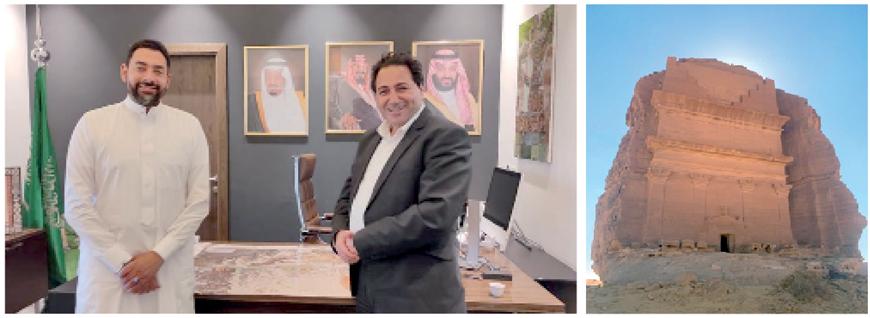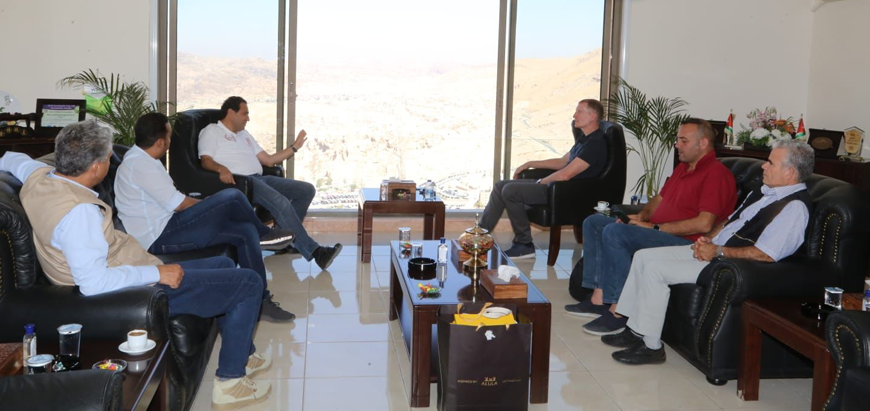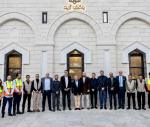You are here
PDTRA delegation visits Al Ula with focus on tourist cooperation with Petra
By Saeb Rawashdeh - Jan 15,2022 - Last updated at Jan 15,2022

Chief Commissioner of Petra Development and Tourism Region Authority Suleiman Farajat (right) poses for a photo with the CEO of the Royal Commission for Al Ula, Amro Madani. Right: A view of Al Hijr also known as Mada’in Saleh in northwest Saudi Arabia (Photos courtesy of PDTRA)
AMMAN — Upon an invitation from the Royal Commission for Al Ula (RCU), Chief Commissioner of Petra Development and Tourism Region Authority (PDTRA) Suleiman Farajat headed a delegation to the ancient city in Saudi Arabia.
The visit, which took place from January 10 to 14, aimed to establish stronger cooperation between the rose-red city of Petra and Al Ula in northwest Saudi Arabia, “as both sites have similar landscape and history, and most importantly, common architecture”, Farajat said.
The region of Al Ula includes the old city of Al Hijr, which has been a world heritage site since 2008 and has a similar façade as Petra, Farajat noted.
“The RCU CEO Amro Madani received us and emphasised the value for both sites to work together in all aspects in the near future,” the PDTRA chief said.
“The Saudi side reassured the strong ties between the two countries and leaderships, and tourism represents a great opportunity to showcase this,” Farajat stressed.
Talking about the historical relevance of Al Ula to Petra, Farajat stressed the site of Al Hijr also known as Mada’in Saleh, which has similar facades to Petra.
“Those facades resemble Nabataean inscriptions that made archaeologist better understand the Nabataean civilisation and gave us an insight into their living culture and religion,” the commissioner said.
“When someone from Petra visits Al Ula, he feels at home and connected,” he added.
Regarding cooperation, Farajat stated that Petra is a well-established international destination and Al Ula is an emerging designation so both sites have the potential to closely work together in the near future in order to have their shares from the international tourism market.
“The two sites are not far from each other and can be marketed together as a regional destination,” Farajat said.
Al Ula is becoming a high-end tourist destination, but has a limited season of six months, he said.
Petra and Al Ula can cooperate in future events, exchange expertise and look for innovative ways of connection, he noted, adding that Saudis expressed their interest in learning from the experience of Petra.
“It was agreed to define channels of cooperation in the near future and have a roadmap for long-term partnership,” Farajat highlighted.
“It is a win-win situation for both destinations. I was very much impressed by the steps the RCU took in order to enhance the position of Al Ula in all aspects especially in how locals are being empowered and how the sites are sustainably managed and presented coupled with the Saudi hospitality,” Farajat said.
The new high-end accommodations and meeting centres, such as Maraya concert hall, are “just stunning and unique” not only in the Middle East but also worldwide, he said.
“Al Ula will certainly take its deserved position in the international tourism faster than anticipated. With its closer cooperation with Petra it will certainly aspire to be called the eighth world wonder and the PDTRA will certainly capitalise on this opportunity,” Farajat concluded.
Related Articles
AMMAN — A high-level delegation from the Saudi Royal Commission for Al Ula on Tuesday visited Petra city to boost cooperation in the tourism
AMMAN — The rose-red city of Petra will witness archaeological excavations to unearth the front courtyard of the Treasury, Petra’s iconic fa
AMMAN — The Petra National Trust (PNT) signed a Memorandum of Understanding with the Royal Commission for AlUla (RCU), celebrating the rich



















